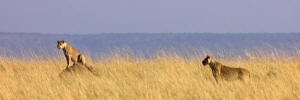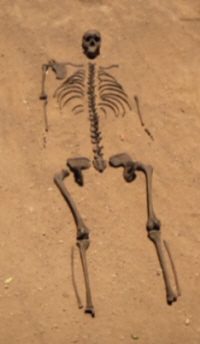Habitat
Origins of Us - Bones
Walking would fundamentally alter the course of our evolutionary history. And the next critical step on the long road to becomin human was driven by a new wave of drastic climate change.
From around three million years ago, East Africa started to dry and the forests shrank back. A brand new habitat was born - the savannah.
This was a whole new world, rich with opportunity, and evolution went into overdrive. There was an explosion of species taking advantage of the expanding grasslands. And, alongside them were a new species of walking ape, who strode out on two legs into the changing landscape, forming new branches of our family tree.

Giving up climbing for walking meant that this group of apes were in the right place at the right time. As the forest receded, the walking ape came into its own. In fact, we know from the fossils that around two million tears ago there were at least six different species of the hominines, these apes which habitually walked on two legs. It was a big, bushy family tree.
But, while most of those lineages would eventually die out, one would go on to be extraordinarily successful. We don't really know why any of the others died out, but the thought that any of our ancestors could have survived in this arid, open environment is difficult to comprehend.
For a relatively puny forest ape, life on the savannah would surely have been a dangerous proposition. So, how did our ancestors survive in the formidable habitat of the open savannah?

This extraordinary fossil skeleton of a young male unearthed in Kenya, gives an insight into how our ancestors not only to survive but to thrive on the savannah. This is a replica of one of the most famous human fossils. And its just remarkable how much of the skeleton has been preserved, how many bones we have here. It date back to one-and-a-half million years ago. He's called KNM-WT 15000, or, perhaps more poetically, Nariokotome Boy. And his bones tell us something really important about a crucial change to our bodies in human evolution.
There are clues all over his skeleton, but the most striking are in the lower half of his body.
Just look at the length of these legs. It is stunning. These long legs really are an important step forward in human evolution. This is the dirst time we've seen domrbody who looks human - he could be walking out there, in this landscape, and you would not notice that he wasn't one of us.
Nariokotome Boy was a member ofa species of early humans known as Homo erectus.
He may be nearly two million years old, but his body plan was obviously highly effective, because from the neck down, he's so similar to us today. But, his brain was only two-thirds the size of ours.
So, is there anything else about him that can tell us how he survived out here? There are plenty of adaptations here to efficient walking, but there also some surprising changes in this skeleton, which don't seem to be related to walking at all. He has very large knees and big hips as well, and in the trunk, he's got a waist - he's got a long narrow waist - the first time we've seen this. His shoulders have also dropped down away from the head, and the back of his skull, there's the sign of attachment of a very special ligament.
Now, all of those changes are to do with stabilising the trunk - not something you really need while you're walking. So, what was this boy doing that destabilised him?
The best place in the world to understand Nariokotome Boy's mysterious physique is not in Africa, but in Boston, at Harvard University. Professor Dan Lieberman's ground-breaking research has revealed that the shape and structure of our bodies has been profoundly affected by a particular form of locomotion - running!
